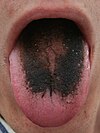Black hairy tongue
| Black hairy tongue | |
|---|---|
| Other names | Lingua villosa nigra[1][2] or Melanoglossia.[3] |
 | |
| A patient displaying characteristic dark bumps of black hairy tongue | |
| Specialty | Dermatology |
| Risk factors | Smoking, poor oral hygiene, soft diet |
| Diagnostic method | Based on clinical appearance |
| Differential diagnosis | Hairy leukoplakia |
| Treatment | Reassurance |
Black hairy tongue syndrome (BHT
Signs and symptoms
Hairy tongue largely occurs in the central part of the dorsal tongue, just anterior (in front) of the
The term "melanoglossia' is also used to refer to there being black discolorations on the tongue without "hairs", which are also harmless and unrelated to black hairy tongue.[7]
Causes
The cause is uncertain,
Transient surface discoloration of the tongue and other soft tissues in the mouth can occur in the absence of hairy tongue. Causes include smoking (or
Diagnosis
Diagnosis is usually made on the clinical appearance without the need for a tissue biopsy.[6] However, when biopsies have been taken, the histologic appearance is one of marked elongation and hyperparakeratosis of the filiform papillae and numerous bacteria growing on the epithelial surface.[6]
Hairy tongue may be confused with
Classification
Hairy tongue (lingua villosa) refers to a marked accumulation of keratin on the filiform papillae on the dorsal surface of the tongue, giving a hair-like appearance.[6] Black tongue (lingua nigra) refers to a black discoloration of the tongue, which may or may not be associated with hairy tongue. However, the elongated papillae of hairy tongue usually develop discoloration due to growth of pigment producing bacteria and staining from food.[6] Hence the term black hairy tongue, although hairy tongue may also be discolored yellow or brown. Transient, surface discoloration that is not associated with hairy tongue can be brushed off.[8] Drug-induced black hairy tongue specifically refers to BHT that develops because of medication. [11] Black hairy tongue can also be caused by antibiotics e.g., (penicillins, cephalosporins, tetracyclines, clarithromycin and linezolid).[12]
Treatment
Treatment is by reassurance, as the condition is benign, and then by correction of any predisposing factors.
Prognosis
BHT is a benign condition,[6][13][14] but people who are affected may be distressed at the appearance and possible halitosis, and therefore treatment is indicated.
Epidemiology
Hairy tongue occurs in about 0.5% of adults.[6] However, the prevalence is variable depending on the population studied.[11]
References
- ISBN 978-81-312-1570-8. Retrieved 16 November 2010.
- PMID 5340144.
- .
- PMID 25152586.
- PMID 2190456.
- ^ ISBN 978-0-7216-9003-2.
- PMID 29002878.
- ^ ISBN 978-0-443-06818-8.
- ISBN 978-0-443-07105-8.
- PMID 20027942.
- ^ S2CID 24501452.
- PMID 33044871.
- PMID 25152586.
- PMID 15679200.
